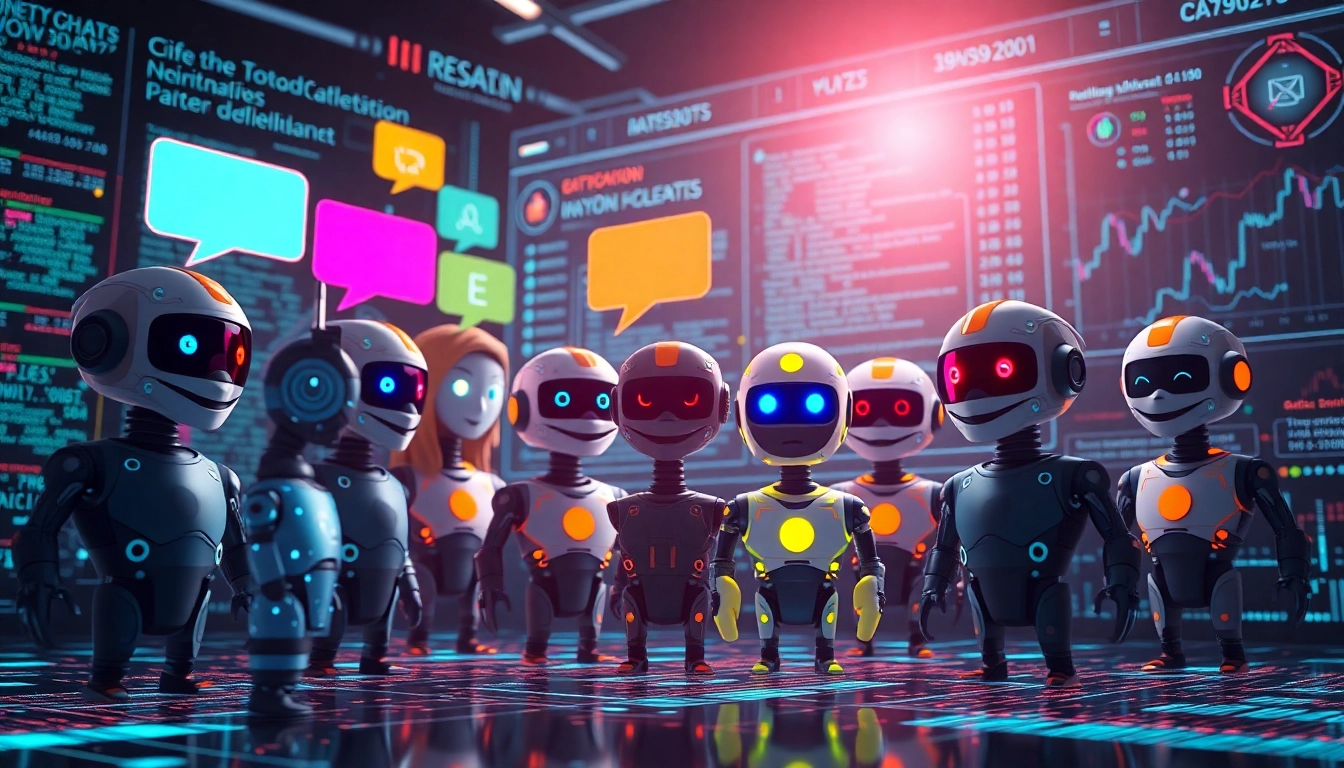1. What is Character AI?
In an age where artificial intelligence is becoming increasingly integrated into daily life, character ai is revolutionizing how we interact with technology. Character AI refers to sophisticated chatbot systems that simulate human-like conversations, allowing users to engage with these virtual personas in various capacities, from casual chat to role-playing scenarios. This innovation is transforming not just entertainment but also learning and customer service, illustrating AI’s diverse potential.
1.1 Definition and Basic Features
Character AI is a type of conversational agent that utilizes natural language processing (NLP) and machine learning algorithms to generate responses that mimic human interaction. These avatars can take on a myriad of personalities, ranging from beloved fictional characters to entirely unique creations. The primary features that set Character AI apart from traditional chatbots include:
- Realistic Interactions: Character AI is designed to provide contextually relevant answers, leading to more lifelike conversations.
- Dynamic Personality: Users can interact with a range of characters, each with distinct traits and dialogue styles.
- Functionality Across Platforms: These AIs can be used in apps, websites, and even games, facilitating versatile interactions.
- Custom User Experiences: Many platforms allow users to create and customize their characters, tailoring interactions to individual preferences.
1.2 The Technology Behind Character AI
The backbone of Character AI is its advanced technology, rooted in a combination of neural networks, deep learning, and extensive datasets. Machine learning algorithms analyze vast amounts of conversational data to teach the AI how to respond appropriately in various contexts. Key components include:
- Natural Language Processing (NLP): This technology enables the AI to comprehend and interpret human language effectively, facilitating smoother exchanges.
- Training Data: Character AI systems are trained on diverse datasets, including books, dialogues from films, and internet forums, which help them adapt to different conversational styles.
- Contextual Understanding: By maintaining conversational context over multiple exchanges, Character AI can provide more coherent and sensible interactions, simulating human dialogues.
1.3 How Character AI Functions
The functioning of Character AI can be broken down into several processes, from user input to response generation. Here’s a streamlined overview:
- User Input: The interaction begins with the user’s text input, which the AI captures for processing.
- Context Analysis: The AI utilizes contextual clues from the conversation history to better understand the intent behind the user’s message.
- Response Generation: Using trained models, the AI formulates a response that aligns with its character profile and the ongoing conversation.
- Response Delivery: The character then presents its response back to the user, often incorporating aspects like humor, empathy, or personality traits.
2. Benefits of Using Character AI
The utilization of Character AI presents numerous advantages that enhance user engagement, providing deeper connections with technology. Below are some of the most prominent benefits:
2.1 Enhanced User Experience
Character AI significantly enhances user experience by making interactions more immersive and enjoyable. This technology allows for:
- Interactive Engagement: Users can contribute to the storyline or develop dialogues, keeping them actively engaged.
- Personalization: The ability to customize characters means that interactions can be tailored to meet individual needs and preferences, fostering a sense of belonging.
2.2 Applications in Different Fields
The versatility of Character AI extends across numerous sectors. Here are a few noteworthy applications:
- Education: In educational platforms, Character AI can act as tutors, providing personalized feedback and assistance based on student performance.
- Entertainment: Video games and interactive storytelling platforms utilize Character AI to enhance narrative experiences, allowing players to forge unique paths.
- Customer Service: Companies use Character AI for customer support, enabling quick responses and reducing wait times, thus improving customer satisfaction.
2.3 Role-Playing and Entertainment
For role-playing enthusiasts, Character AI introduces a new realm of possibilities. Whether chatting with historical figures or participating in fantastical scenarios, users can:
- Create Custom Characters: Users can design characters that match their imaginations.
- Explore Diverse Narratives: Engaging with the AI in varied scenarios allows players to experience stories differently, with each interaction offering fresh surprises.
3. Common Challenges with Character AI
While Character AI offers distinct advantages, it comes with its own set of challenges that users must navigate. Recognizing these issues can lead to more fruitful interactions.
3.1 Understanding Limitations
Character AI is not without its flaws. One notable limitation is its reliance on pre-existing data. It may struggle with:
- Contextual Misunderstanding: Sometimes, the AI may misinterpret user inputs if the context isn’t adequately established, leading to irrelevant or nonsensical responses.
- Rigid Dialogue Structures: While some characters can engage dynamically, others may repeat patterns, making conversations feel formulaic.
3.2 Addressing Ethical Concerns
As with any technology, Character AI raises ethical questions surrounding privacy, consent, and the implications of authenticity. Issues to consider include:
- User Data Protection: Safeguarding users’ data and ensuring that personal information isn’t exploited is paramount.
- AI-Generated Content: The line between AI-generated content and human creativity can blur, raising concerns about originality and authorship.
3.3 Managing User Expectations
Another challenge for developers and users alike is managing expectations. The hype around AI capabilities can lead to:
- Over-promising: Expectations can be set too high, leading to disappointments when the AI fails to deliver.
- Misuse or Misinterpretation: Without clarity on the limitations, users might misinterpret the AI’s capabilities, expecting it to behave like a human.
4. Best Practices for Engaging with Character AI
To maximize the enjoyment and effectiveness of interacting with Character AI, users should consider a few best practices that enhance engagement and satisfaction.
4.1 Creating Meaningful Interactions
To foster deeper connections, users should aim to:
- Provide Context: The more context provided about a conversation, the more accurately the AI can respond.
- Explore Different Scenarios: Engaging with the AI across various narratives can unveil its complexities, making interactions more enjoyable.
4.2 Setting Up a Character AI Session
When initiating a session, it’s essential to:
- Select the Right Character: Choosing a character that resonates with your preferences can lead to a more fulfilling experience.
- Set Clear Objectives: If there are specific outcomes desired from the interaction, articulating them early on can guide the conversation.
4.3 Customizing Your Experience
Character AI platforms often provide customization options. Users should:
- Adjust Personality Traits: Tailoring a character’s traits can enhance compatibility and enjoyment in interactions.
- Manage Conversation Depth: Users should understand their preferences for casual vs. deep conversations, adjusting settings accordingly.
5. Future Trends in Character AI
The future of Character AI appears promising as the technology evolves. Emerging trends can shape its trajectory and influence how users interact with virtual assistants.
5.1 Innovations on the Horizon
Anticipated innovations include:
- Increased Personalization: Future AI may offer even more tailored experiences, adapting to user learning styles and emotional responses.
- Advanced Emotional Intelligence: There may be developments in emotional responses, allowing AI to better empathize with user sentiments.
5.2 Integration with Other Technologies
Integration with augmented reality (AR) and virtual reality (VR) could enhance the functionality of Character AI, creating immersive experiences that combine physical and digital worlds. This could lead to:
- Virtual Companions: Users might engage with AI characters in virtual environments, enhancing social interactions.
- Gamified Experiences: The blend of gaming mechanics with conversational AI could create captivating experiences that are both entertaining and educational.
5.3 Predicting User Engagement Patterns
As the user base grows, understanding engagement patterns will be crucial. Data analytics can reveal:
- User Preferences: Analyzing user interactions can help developers improve characters and functionalities.
- Behavioral Insights: Tracking user behavior can lead to more intuitive AI that adapts fluidly to expectations and needs.



